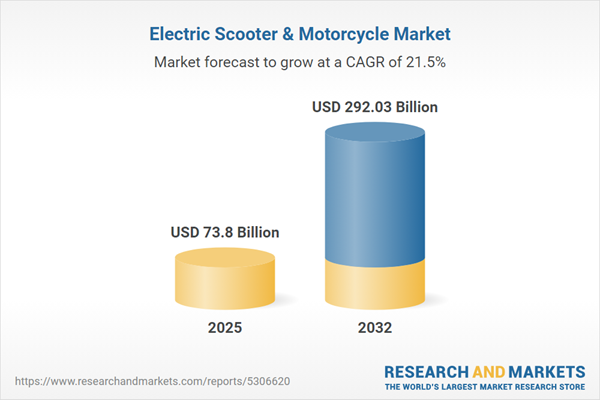Speak directly to the analyst to clarify any post sales queries you may have.
The electric scooter and motorcycle market is rapidly reshaping urban mobility, presenting substantial opportunities for stakeholders focused on sustainable and efficient transport solutions. Senior decision-makers seeking actionable intelligence will find this report provides essential clarity on market drivers, segmentation, policy impacts, and competitive strategies.
Market Snapshot: Electric Scooter & Motorcycle Market Growth Drivers
The Electric Scooter & Motorcycle Market grew from USD 61.46 billion in 2024 to USD 73.80 billion in 2025. It is expected to continue growing at a CAGR of 21.50%, reaching USD 292.03 billion by 2032. This expansion is underpinned by urbanization, tightening emissions policies, and strong demand for zero-emission vehicles in major economies. Advances in battery technologies and digital integration contribute significantly to an enhanced user experience and operational efficiency. Market momentum is further propelled by stakeholders responding to both regulatory shifts and evolving consumer preferences.
Scope & Segmentation
- Vehicle Types: Electric motorcycles (including dirt bikes, sports motorcycles), electric scooters (covering folding and three-wheeled models).
- Battery Types: Lead acid, lithium ion (notably lithium iron phosphate, nickel manganese cobalt), nickel metal-hydride, and solid state batteries.
- Motor Types: Brushed DC, brushless DC, and permanent magnet synchronous motors.
- Power Output: Below 3 kilowatts, 3–10 kilowatts, above 10 kilowatts.
- Range per Charge: Below 60 kilometers, 60–120 kilometers, above 120 kilometers.
- End Users: Commercial (logistics, shared mobility), individual, law enforcement, and municipal fleets.
- Distribution Channels: Offline and online retail and service platforms.
- Regions: Americas (including the United States, Canada, Mexico, Brazil, Argentina, Chile, Colombia, Peru), Europe, Middle East & Africa (including the United Kingdom, Germany, France, Russia, Italy, Spain, Netherlands, Sweden, Poland, Switzerland, United Arab Emirates, Saudi Arabia, Qatar, Turkey, Israel, South Africa, Nigeria, Egypt, Kenya), Asia-Pacific (including China, India, Japan, Australia, South Korea, Indonesia, Thailand, Malaysia, Singapore, Taiwan).
- Key Companies: Yadea Technology Group, Hero Electric Vehicles, AIMA Technology Group, Niu International, Zero Motorocycles, Vmoto, Piaggio Group, Ather Energy, Gogoro, Harley-Davidson, and others.
Key Takeaways for Electric Scooter & Motorcycle Market Decision-Makers
- Zero-emission two-wheelers are accelerating the transition to sustainable urban transportation, spurred by policy incentives and evolving regulatory mandates.
- Technological innovation in battery chemistry and motor design is reducing range anxiety and enabling diverse applications, from last-mile logistics to municipal fleets.
- OEMs and suppliers are increasing investments in localized production and strategic supply partnerships to counteract emerging tariff and trade complexities.
- Shared micromobility platforms and digital sales channels are redefining ownership models, supporting both commercial and individual use cases.
- Regional demand patterns and regulatory environments are shaping product fit and market entry strategies for global and local manufacturers alike.
- The aftermarket, including maintenance and digital telematics services, is becoming an important profitability lever amid intensifying competition.
Tariff Impact and Supply Chain Realignment
Revised United States tariffs on electric scooter and motorcycle imports in 2025 are precipitating shifts in sourcing, cost structures, and production location decisions. Manufacturers are prioritizing domestic assembly, exploring joint ventures, and negotiating free trade zone arrangements to offset tariffs. Suppliers are diversifying operations into new geographies, such as Mexico and Southeast Asia, balancing trade compliance with efficient logistics. As brands recalibrate, value-added features and aftermarket support surface prominently in go-to-market strategies.
Methodology & Data Sources
This research is rooted in dual-phase methodology: primary interviews with OEMs, suppliers, regulators, and fleet operators combined with comprehensive secondary reviews of published industry data, regulatory filings, and technical literature. Data triangulation and quantitative benchmarking ensure the validity and reliability of market insights delivered in the analysis.
Why This Report Matters
- Equips leaders with a clear framework to interpret regulatory trends, technological advancements, and shifting market structures.
- Delivers granular segmentation and actionable intelligence to support investment, portfolio diversification, and supply chain decisions.
- Enables proactive market entry or expansion strategies aligned to regional dynamics and evolving product requirements.
Conclusion
The electric scooter and motorcycle market is evolving rapidly, propelled by technology, policy, and consumer shifts. Stakeholders that anticipate change and forge resilient, customer-focused strategies are best positioned for sustainable growth.
Additional Product Information:
- Purchase of this report includes 1 year online access with quarterly updates.
- This report can be updated on request. Please contact our Customer Experience team using the Ask a Question widget on our website.
Table of Contents
3. Executive Summary
4. Market Overview
7. Cumulative Impact of Artificial Intelligence 2025
Companies Mentioned
The companies profiled in this Electric Scooter & Motorcycle market report include:- Yadea Technology Group Co., Ltd.
- Hero Electric Vehicles Pvt. Ltd.
- AIMA Technology Group Co. Ltd.
- Niu International Co. Ltd.
- Zhejiang Luyuan Electric Vehicle Co. Ltd.
- Zero Motorocycles, Inc.
- Vmoto Ltd.
- Dongguan Tailing Electric Vehicle Co. Ltd.
- Piaggio Group
- Ather Energy Pvt. Ltd.
- Energica Motor Company S.p.A.
- Gogoro Inc.
- Urban Ecomobility
- Askoll EVA S.p.A.
- Okinawa Autotech Internationall Pvt. Ltd.
- Govecs Group
- Ultraviolette Automotive Pvt Ltd.
- Revolt Intellicorp Private Limited
- Z Electric Vehicle Corporation
- CAKE 0 Emission AB
- Lightning Motors Corporation
- Johammer e-mobility GmbH
- Harley-Davidson, Inc.
- Bayerische Motoren Werke AG
- Greaves Electric Mobility Pvt. Ltd.
- Cezeta
- Terra Motors Corporation
- TVS Motor Company
- Damon Motors Inc.
- Chetak Technology Limited by Baja Auto Ltd.
Table Information
| Report Attribute | Details |
|---|---|
| No. of Pages | 194 |
| Published | October 2025 |
| Forecast Period | 2025 - 2032 |
| Estimated Market Value ( USD | $ 73.8 Billion |
| Forecasted Market Value ( USD | $ 292.03 Billion |
| Compound Annual Growth Rate | 21.5% |
| Regions Covered | Global |
| No. of Companies Mentioned | 31 |









